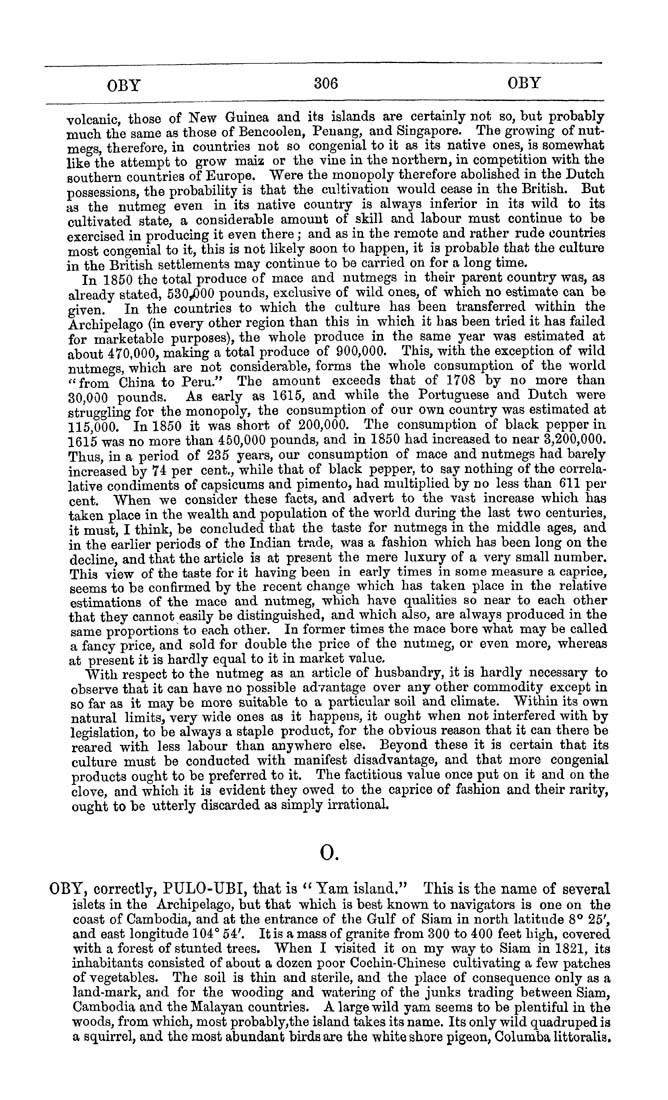OBY 306 OBY
volcanic, those of New Guinea and its islands are certainly not so, but probably
much the same as those of Bencoolen, Penang, and Singapore. ^ The growing of nut¬
megs, therefore, in countries not so congenial to it as its native ones, is somewhat
like the attempt to grow maiz or the vine in the northern, in competition with the
southern countries of Europe. Were the monopoly therefore abolished in the Dutch
possessions, the probability is that the cultivation would cease in the British. But
as the nutmeg even in its native country is always inferior in its wild to its
cultivated state, a considerable amount of skill and labour must continue to be
exercised in producing it even there; and as in the remote and rather rude countries
most congenial to it, this is not likely soon to happen, it is probable that the culture
in the British settlements may continue to be carried on for a long time.
In 1850 the total produce of mace and nutmegs in their parent country was, as
already stated, 530^00 pounds, exclusive of wild ones, of which no estimate can be
given. In the countries to which the culture has been transferred within the
Archipelago (in every other region than this in which it has been tried it has failed
for marketable purposes), the whole produce in the same year was estimated at
about 470,000, making a total produce of 900,000. This, with the exception of wild
nutmegs, which are not considerable, forms the whole consumption of the world
"from China to Peru." The amount exceeds that of 1708 by no more than
30,000 pounds. As early as 1615, and while the Portuguese and Dutch were
struggling for the monopoly, the consumption of our own country was estimated at
115,000. In 1850 it was short of 200,000. The consumption of black pepper in
1615 was no more than 450,000 pounds, and in 1850 had increased to near 3,200,000.
Thus, in a period of 235 years, our consumption of mace and nutmegs had barely
increased by 74 per cent., while that of black pepper, to say nothing of the correla-
lative condiments of capsicums and pimento, had multiplied by no less than 611 per
cent. When we consider these facts, and advert to the vast increase which has
taken place in the wealth and population of the world during the last two centuries,
it must, I think, be concluded that the taste for nutmegs in the middle ages, and
in the earlier periods of the Indian trade, was a fashion which has been long on the
decline, and that the article is at present the mere luxury of a very small number.
This view of the taste for it having been in early times in some measure a caprice,
seems to be confirmed by the recent change which has taken place in the relative
estimations of the mace and nutmeg, which have qualities so near to each other
that they cannot easily be distinguished, and which also, are always produced in the
same proportions to each other. In former times the mace bore what may be called
a fancy price, and sold for double the price of the nutmeg, or even more, whereas
at present it is hardly equal to it in market value.
With respect to the nutmeg as an article of husbandry, it is hardly necessary to
observe that it can have no possible advantage over any other commodity except in
so far as it may be more suitable to a particular soil and climate. Within its own
natural limits, very wide ones as it happens, it ought when not interfered with by
legislation, to be always a staple product, for the obvious reason that it can there be
reared with less labour than anywhere else. Beyond these it is certain that its
culture must be conducted with manifest disadvantage, and that more congenial
products ought to be preferred to it. The factitious value once put on it and on the
clove, and which it is evident they owed to the caprice of fashion and their rarity,
ought to be utterly discarded as simply irrational.
0.
OBY, correctly, PULO-UBI, that is ^* Yam island." This is the name of several
islets in the Archipelago, but that which is best known to navigators is one on the
coast of Cambodia, and at the entrance of the Gulf of Siam in north latitude 8** 25',
and east longitude 104° 54'. It is a mass of granite from 300 to 400 feet high, covered
with a forest of stunted trees. When I visited it on my way to Siam in 1821, its
inhabitants consisted of about a dozen poor Cochin-Chinese cultivating a few patches
of vegetables. The soil is thin and sterile, and the place of consequence only as a
land-mark, and for the wooding and watering of the junks trading between Siam,
Cambodia and the Malayan countries. A large wild yam seems to be plentiful in the
woods, from which, most probably,the island takes its name. Its only wild quadruped is
a squirrel, and the most abundant birds are the white shore pigeon, Columba littoralis.
|








